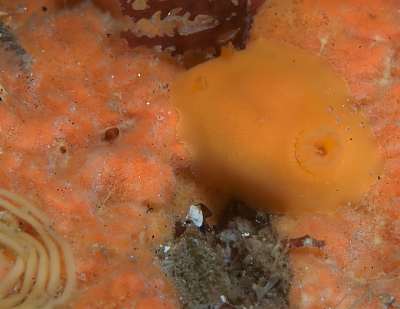
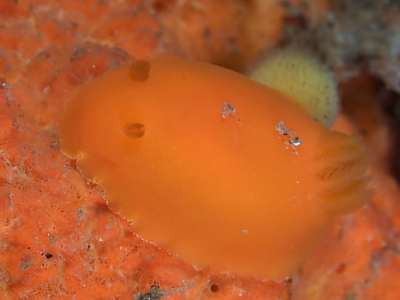
Rostanga pulchra
MacFarland, 1905
Order: NUDIBRANCHIA
Suborder: DORIDINA
Superfamily: EUDORIDOIDEA
Family: Dorididae
DISTRIBUTION
West Coast of North America. Records exist from Alaska to Gulf of California, Mexico, and also Chile and Argentina in South America. It is possible that more than one species is included in these records, as most species of Rostanga look very similar externally.
PHOTO
North Monastery Beach, Carmel, California, USA. Depth: 15 meters. Length: 20-30 mm. 16 November 2005. Boulder Slope. Photographer: Mike Jimenez
This well-known species from the west coast of both North and South America is another red species with vertically arranged rhinophore lamellae. It differs from all described species with this rhinophore type in having a few large inner denticles on the innermost radular teeth and a few long terminal denticles on the outer teeth.
MacFarland (1966) lists records of R. pulchra on a variety of red siliceous sponges but, as Cook (1962) argues, these do not indicate whether the nudibranch is actually feeding on a particular sponge. Cook clearly shows that R. pulchra is chemically attracted to and feeds on Ophlitaspongia pennata Labbe and this sponge is usually noted as the common food sponge of Rostanga pulchra. The literature on feeding in R. pulchra well illustrates the problems of using unverifiable sponge identifications in interpreting feeding ecology. Bakus & Abbott (1980: 26-27), in describing the sponges of California note under the description of the red poecilosclerid Axocielita originalis (De Laubenfels, 1930) that:
"Five other intertidal sponges in California are practically identical with this one in gross appearance and difficult to distinguish in the field: Microciona microjoanna, Ophlitaspongia pennata, Isociona lithophoenix, Plocamia karykina and Plocamilla illgi".
Axocielita originalis and the first four species in the list have all been reported as food for R. pulchra. Although it may be that R. pulchra feeds on a wide variety of red sponges, only Ophlitaspongia pennata has been confirmed as a chosen food (Cook, 1962; Chia & Koss, 1978). See also Brian Penney's message on feeding. The developmental biology of this species has been exhaustively studied (Chia & Koss, 1978, 1982; Chia, Koss & Bickell, 1981). The bright red eggs are laid in a multispiralled ribbon which differs from the other species described here in being almost cylindrical in shape (Hurst, 1967; Beeman & Williams, 1980).
Reference:
• Rudman, W.B. & Avern, G.J. (1989) The genus Rostanga Bergh, 1879 (Nudibranchia: Dorididae) in the Indo-West Pacific. Zoological Journal of the Linnean Society 96: 281-338.
Rudman, W.B., 2002 (February 4) Rostanga pulchra MacFarland, 1905. [In] Sea Slug Forum. Australian Museum, Sydney. Available from http://www.seaslugforum.net/find/rostpulc
Related messages
Re: Rostanga pulchra from Vancouver Island
August 28, 2008
From: Jeff Goddard
Concerning message #21520:
Hi Bill,
I was just catching up on messages posted recently on the SSF forum and wanted to comment on Dave's response to message #21520. The Rostanga pulchra in Jackie Hildering's image are typical looking for individuals out of the water, when the very fine texture caryophllidia cannot be discerned with the naked eye. Second, both egg masses are also typical for the species; the paler, broken coil is merely at a later stage of development and is breaking down (and flimsier) with the hatching of the veliger larvae. Finally, good eyes, grade 9 science class of Port Hardy Secondary School!
As an aside, the red-orange sponge is likely Ophlitaspongia pennata, the most common prey species for Rostanga pulchra intertidally in the Pacific northwest, and the tan-colored, slick-surfaced patches surrounding the Ophlitaspongia are the slime sponge, Halisarca, which is the sole prey of Hallaxa chani. A few patches of a Haliclona -like haplosceridan sponge are also present; these are typically consumed by Diaulula sandiegensis. The entire scene is reminiscent of what I have often observed under intertidal cobbles in Oregon and Washington.
Best wishes,
Jeff
goddard@lifesci.ucsb.edu
Goddard, J.H.R., 2008 (Aug 28) Re: Rostanga pulchra from Vancouver Island. [Message in] Sea Slug Forum. Australian Museum, Sydney. Available from http://www.seaslugforum.net/find/21831Dear Jeff,
Thanks for sorting out the egg mass differences and for the background information on the other sponges.
Best wishes,
Bill Rudman
Re: Rostanga pulchra from Vancouver Island
July 30, 2008
From: Jackie Hildering
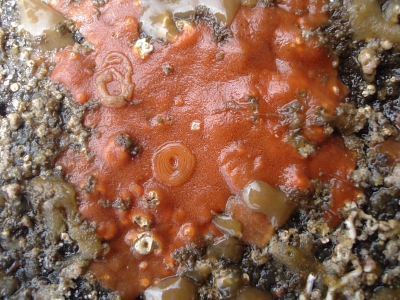
Concerning message #16094:
Here some more little orange blobs of Rostanga pulchra with their eggs. Animals and eggs were found and identified by the grade 9 science class of Port Hardy Secondary School.
Locality: Port Hardy , intertidal, British Columbia, Canada. Pacific Ocean, 10 April 2008, Intertidal. Length: 2 cm. Photographer: Jackie Hildering.
Jackie Hildering
earthlingenterprises@telus.net
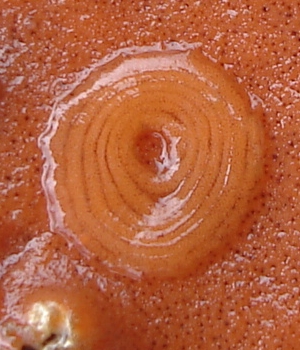
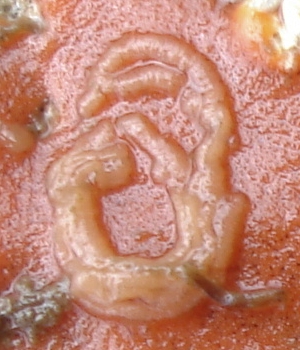

Hi Jackie,
Interesting submission, but puzzling too. The dorids look a bit shiny for Rostanga which is usually covered with caryophllidia, but maybe these two have secreted slime. The other puzzle is that the two eggs ribbons are quite different morphologically, suggesting that could from different species. The second, whitish ribbon appears to be a wide ribbon attached on edge, whereas the more classical Rostanga ribbon is tighter and flat. I guess we will never know.
Best wishes,
Dave Behrens
Behrens, D.W., 2008 (Jul 30). Comment on Re: Rostanga pulchra from Vancouver Island by Jackie Hildering. [Message in] Sea Slug Forum. Australian Museum, Sydney. Available from http://www.seaslugforum.net/find/21520
Rostanga pulchra from La Jolla, California
July 31, 2007
From: Kevin Lee
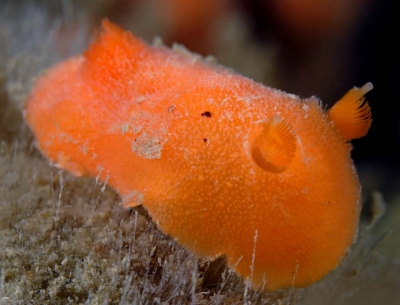
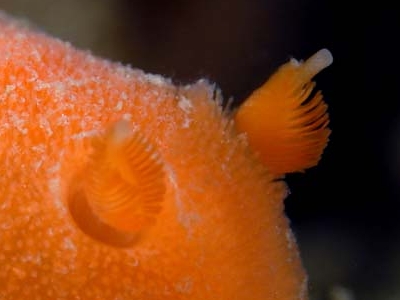
Hi Doc,
Thought I'd share these shots of the Red Dorid, Rostanga pulchra, found off the coast of Southern California. It was a first for me. The rhinophore shape is rather funky and unique.
Locality: Pt. Loma, La Jolla, approx. 70fsw, California, USA, Eastern Pacific Ocean, 16 May 2007, Reef. Length: 1.5 inch. Photographer: Kevin Lee.
Kevin Lee.
diverkevin@gmail.com
Lee, K., 2007 (Jul 31) Rostanga pulchra from La Jolla, California. [Message in] Sea Slug Forum. Australian Museum, Sydney. Available from http://www.seaslugforum.net/find/20321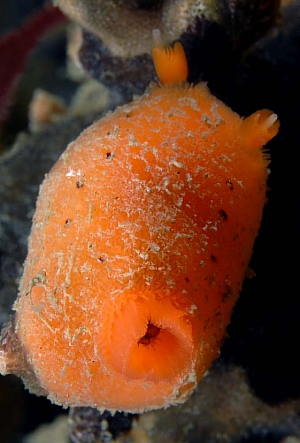
Dear Kevin,
It certainly seems a good week for nice photos of Rostangarhinophores. You can also see in the photo alongside the way that Rostanga gills are usually shorter and more compact than most dorids, the gill circlet forming an upright tube in most species, perhaps to mimic the siphons of the sponge colonies on which they feed.
Best wishes,
Bill Rudman
Rostanga pulchra from Point Lobos, California
July 23, 2007
From: Clinton Bauder
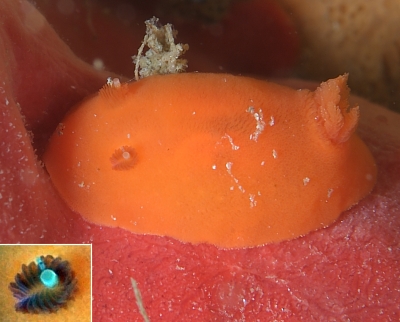
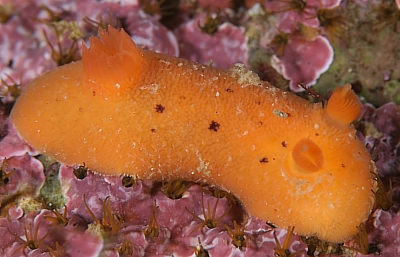
Hi Bill and Dave,
Jackie's animal in message #20139 reminded me that I have some more nice pictures of Rostanga pulchra from Point Lobos that show the details of the gills and rhinophores perhaps better than the images already on the forum. One of them also has it on a pink sponge that's a bit different from the orange sponges I usually see them on.
Locality: Point Lobos State Reserve, 15 meters, California, USA, Pacific, 4 March 2007 [lower photo] and 22 May 2007 [upper photo], Rocky Reef. Length: 20 mm. Photographer: Clinton Bauder.
By the way, for what it's worth (and that's probably not very much) I agree with Dave that Jackie's animal is Rostanga based on the rhinophores.
Clinton
gecko1@apple.com
Bauder, C., 2007 (Jul 23) Rostanga pulchra from Point Lobos, California. [Message in] Sea Slug Forum. Australian Museum, Sydney. Available from http://www.seaslugforum.net/find/20189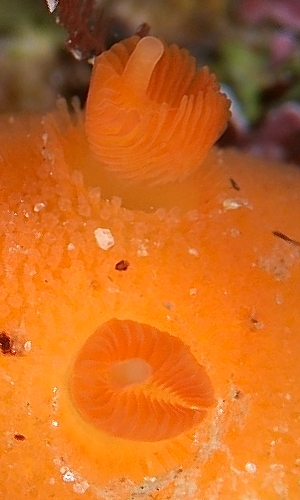
Dear Clinton,
Thanks for these great photos. I think its the best Rostanga rhinophore photo I have seen. Not all species of Rostanga have these rhinophores with almost vertical lamellae, but quite a few do. [I have played around with the colour in the rhinophore inset in top photo to show detail].
We can also see the caryophyllidia [tubercles with a crown of spicules] which cover the mantle in species of Rostanga and Jorunna
Best wishes,
Bill Rudman
Re: Aldisa cooperi? from British Columbia
July 11, 2007
From: Jackie Hildering
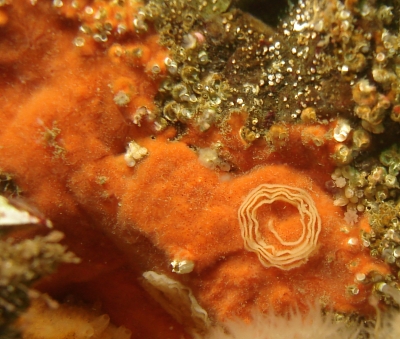
Hello Bill
Thought that these images of Aldisa cooperi with its eggs mass may be of value to the Forum. It may also be of interest to see the animal, not on Anthoarcuata graceae but on Scarnus erithacus.
Locality: NE Pearse, 50 feet, British Columbia, Canada, Pacific Ocean, 21 May 2007, Wall. Length: +/- 2 cm. Photographer: Jackie Hildering.
Jackie Hildering
earthlingenterprises@telus.net
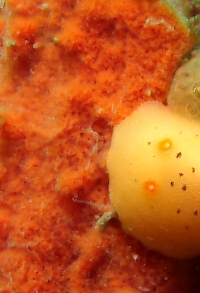
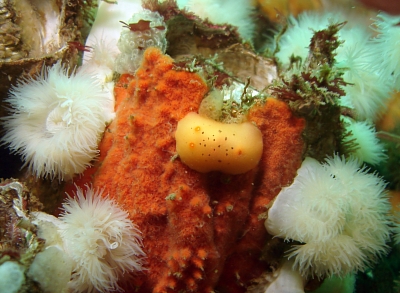
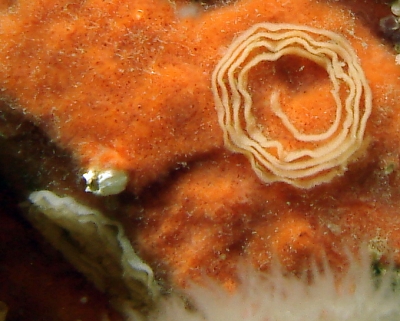
Hi Jackie,
Well, hummmm. I am not sure this is Aldisa cooperi at all. The dorsal spots are not right and we cannot see the gill well enough to be sure. Also, the eggs are certainly not. With Bill's help, I am going to guess that this is a very pale Rostanga pulchra based on the morphology of the rhinophores. Also R. pulchra often has scattered dark specks. Please remember that identifying species of nudibranchs from photos is not a perfect science.
Hope I am right,
Dave Behrens
Spotted Rostanga pulchra from Point Lobos, CA
February 7, 2007
From: Clinton Bauder
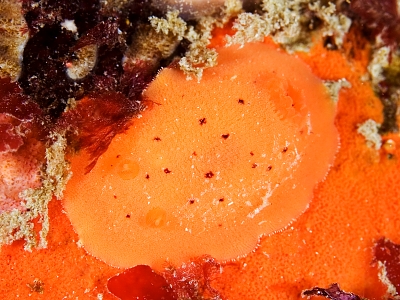
Hi Bill,
Was out branching at Point Lobos last week and we found quite a few of the spotted form of Rostanga pulchra. Usually the ones we find in central California don't have the dark spots.
Picture is by my friend Mike Jimenez.
Locality: Point Lobos, 10 meters, California, USA, Pacific, 01 February 2007, Rocky Reef. Length: 10mm. Photographer: Michael Jimenez.
Clinton
gecko1@apple.com
2007 (Feb 7) Spotted Rostanga pulchra from Point Lobos, CA. [Message in] Sea Slug Forum. Australian Museum, Sydney. Available from http://www.seaslugforum.net/find/19403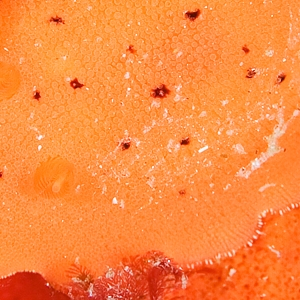
Hi Clinton,
I like to call this the salt and pepper form of Rostanga pulchra. Actually I find that specimens with some degree of specking (black or white of the notal surface) are more common that the pure red variant. For some reason I seem to remember the red variant more common feeding on intertidal sponges, and the speckled variants feeding subtidally.
Thanks for the great observation,
Dave Behrens
Rostanga pulchra or Aldisa cooperi?
March 30, 2006
From: Minette Layne
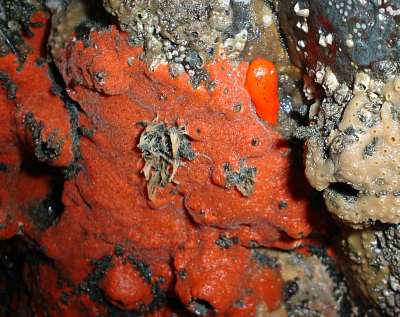
I'm wondering if you can help me to identify this nudibranch.
When I took this photograph, I assumed that the red nudibranch was Rostanga pulchra. It seemed a bit out of the ordinary to me, because of its rather large size (approximately 1") and because of the little black speckles along its back, but a little bit of reading (in David Behren's "Pacific Coast Nudibranchs") turned up a reference to Rostanga of that size and with those markings, so I considered it a positive ID.
I keep coming back to the picture, however, and wonder if the nudibranch in question isn't Aldisa cooperi instead of Rostanga pulchra.
Locality: Sooke, Intertidal, British Columbia, Canada, Strait of Juan de Fuca, June 2005, In a small sea cave. Length: 1". Photographer: Minette Layne.
The picture quality is so poor that it might be impossible to make a definitive ID, but I'm curious if you or one of the other participants on the forum can see something obvious about this critter that can help me identify it with more certainty.
Minette Layne
minette_layne@hotmail.com
Layne, Minette, 2006 (Mar 30) Rostanga pulchra or Aldisa cooperi?. [Message in] Sea Slug Forum. Australian Museum, Sydney. Available from http://www.seaslugforum.net/find/16174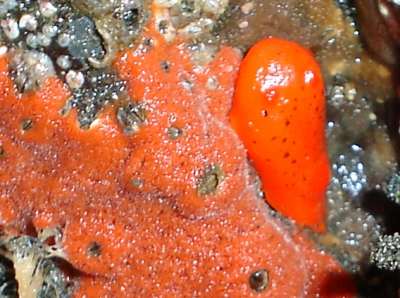
Dear Minette,
The identification of individuals out of the water is always challenging. All the characteristics are laying limp. My guess however is that your critter is Rostanga pulchra, because of the scattered spots. Incidentally, Sooke (pronounced - ta-suck by the native people) is one of my favorite places on this coast.
Now I need to put the work back on your shoulders -- hopefully you can return to the red sponge. Your critter will likely still be there. Rostanga has very unique rhinophores, see the drawing in my book. The rhinophores of Aldisa are perfoliate, like most dorids.
Also, the dorsal surface of Rostanga is covered with numerous small papillae with spicules protruding (caryophyllidia). The dorsal surface of Aldisa has low tubercles.
Get your animal underwater - in a dish - and check out these features. Good luck.
Best wishes,
Dave Behrens
Rostanga pulchra from Vancouver Island
March 22, 2006
From: Minette Layne
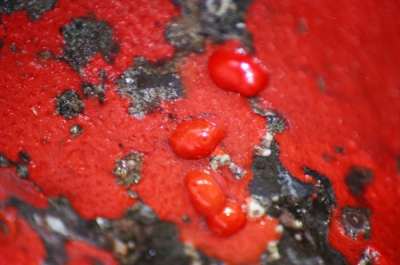
I thought you might enjoy seeing this picture of four Rostanga pulchra nudibranchs that appear to be eating some sponge.
The slugs were in the intertidal zone, inside a small sea cave and I've found them in approximately the same spot for the past four years (different specimens, I can only assume).
Locality: Point-No-Point, near Sooke, on Vancouver Island, Intertidal, British Columbia, Canada, Strait of Juan de Fuca, 24 June 2005, Intertidal, on sponge on a rock ledge. Length: 1 to 1 1/2 centimeters. Photographer: Minette Layne.
Minette Layne
minette_layne@hotmail.com
Layne, M., 2006 (Mar 22) Rostanga pulchra from Vancouver Island. [Message in] Sea Slug Forum. Australian Museum, Sydney. Available from http://www.seaslugforum.net/find/16094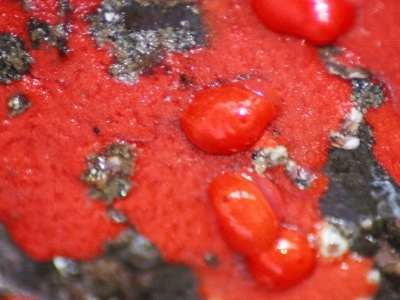
Dear Minette,
Yes - I believe these shiny little red blobs are Rostanga pulchra. You photo is nearly identical to the intertidal shot in Andy Lamb's new book.
This species must secrete a slime to keep it from drying out at low tide. When I first looked at your photo I thought it might be the Broadbase Tunicate, Cnemidocarpa finmarkiensis, that also occurs in this region. It is also shown in Lamb & Hanby (2005).
-
Lamb, A. & B.P. Hanby. 2005. Marine Life of the Pacific Northwest. Harbour Publishing.
Best wishes,
Dave Behrens
Rostanga pulchra from Carmel, CA
November 21, 2005
From: Clinton Bauder


Hi Bill,
Since Rostanga pulchra has been a topic of discussion lately my friend Mike and I went looking for them Wed night. We found several on their food sponge.
Locality: North Monastery Beach, Carmel, California, USA. Depth: 15 meters. Length: 20-30 mm. 16 November 2005. Boulder Slope. Photographer: Mike Jimenez
Clinton
gecko1@apple.com
Bauder, C., 2005 (Nov 21) Rostanga pulchra from Carmel, CA. [Message in] Sea Slug Forum. Australian Museum, Sydney. Available from http://www.seaslugforum.net/find/15313Dear Clinton & Mike,
Thanks for thinking of us. With its tight circle of gills and upright thinophore leaflets, this certainly looks like a species of Rostanga. I guess that is its egg ribbon in the upper photo?
Best wishes,
Bill Rudman
Rostanga pulchra from San Juan Islands
September 19, 2005
From: Paul Sim
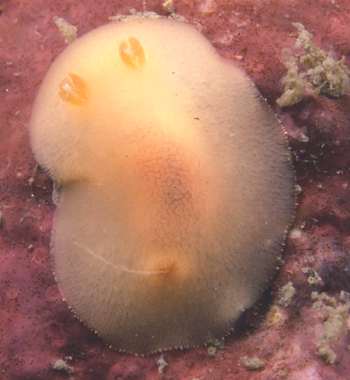
Hello Bill.
This photo comes from a divesite in the San Juan Islands where I counted 20 species of nudibranchs on a single dive. Is this some kind of record? On a nearby islet I counted 22. If you are intersted I could list them out for you. Anyway, I have named this Rostanga pulchra because I could not find anything else that seemed to match although I have never seen one as red as the images on your website. I have several photo's from around British Columbia and the San Juans and they are all orange. Do I have the species wrong?
Locality: Bell Island, San Juan Islands, Washington, USA. NE Pacific. Depth: 50 feet. Length: 7 mm.1 July 2005. Wall and Rocks. Photographer:
Paul Sim
plsim@shaw.ca
Sim, P., 2005 (Sep 19) Rostanga pulchra from San Juan Islands . [Message in] Sea Slug Forum. Australian Museum, Sydney. Available from http://www.seaslugforum.net/find/14587Dear Paul,
It ceratainly looks very pale but the rhinophores and the caryophyllidia on the mantle suggest Rostanga, and as R. pulchra is the only species known from there I assume your is a juvenile. Hopefully someone will confirm that for us.
Best wishes,
Bill Rudman
Re: Food of Rostanga pulchra
August 8, 2002
From: Cynthia Trowbridge
Dear Bill,
Concerning unpublished theses: In the U.S., we are required to send a copy of our thesis to UMI Dissertation Services to create an accessible microfilm copy for distribution. Photocopies are available of all PhDs and many MSc theses for a rather modest cost at the following web site:
http://tls.il.proquest.com/hp/Products/DisExpress.html
There is a searchable database so you can find all those unpublished opisthobranch theses and buy them with a credit card. The Anderson thesis is there (I checked). I thought many people might be interested in this resource.
Thanks!
Cynthia
trowbric@onid.orst.edu
Trowbridge, C., 2002 (Aug 8) Re: Food of Rostanga pulchra. [Message in] Sea Slug Forum. Australian Museum, Sydney. Available from http://www.seaslugforum.net/find/7734Thanks Cynthia,
Very glad to hear of this service and I am sure others will be as well
Bill Rudman
Food of Rostanga pulchra
August 7, 2002
From: Brian Penney
Hi Bill-
Concerning your comments on the food of Rostanga pulchra. Actually, several other sponges have been confirmed as prey for R. pulchra, though in a PhD. thesis that, to my knowledge, was never published elsewhere. See:
• Anderson, E. S. 1971. The association of the nudibranch Rostanga pulchra MacFarland 1905 with the sponges Ophlitaspongia pennata, Esperiopsis originalis, and Plocamia karykina. PhD. Dissertation. University of California, Santa Cruz, Biology, Santa Cruz, CA.
She identified spicules present in the gut and/or feces, so as reliable as we can get.
Cheers,
Brian
bpenney@ualberta.ca
Penney, B., 2002 (Aug 7) Food of Rostanga pulchra. [Message in] Sea Slug Forum. Australian Museum, Sydney. Available from http://www.seaslugforum.net/find/7725Thanks Brian,
Its unfortunate that work like this is never published.
Cheers,
Bill Rudman
Rostanga pulchra from Carmel, CA
February 14, 2002
From: Clinton Bauder
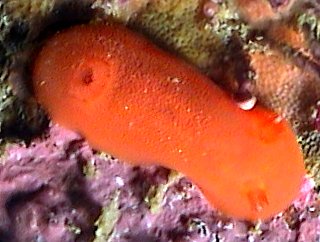
Hi Bill,
Here is a picture of Rostanga pulchra. It was taken at Lincod Reef near Pescadero Point in Carmel, California. Depth was about 15m and the animal is maybe 20mm long.
Clinton
gecko1@apple.com
Bauder, C., 2002 (Feb 14) Rostanga pulchra from Carmel, CA. [Message in] Sea Slug Forum. Australian Museum, Sydney. Available from http://www.seaslugforum.net/find/6208Thanks Clinton,
Bill Rudman
Rostanga pulchra from Vancouver Island
February 4, 2002
From: Bill Rudman
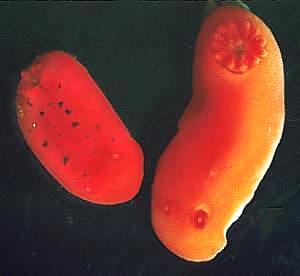
Here is a photo of Rostanga pulchra.
Point No Point, near River Jordan, Vancouver Id, BC, Canada. 22 May 1962. Photo: R.C. Malkin.:
BIll Rudman
Rudman, W.B., 2002 (Feb 4) Rostanga pulchra from Vancouver Island. [Message in] Sea Slug Forum. Australian Museum, Sydney. Available from http://www.seaslugforum.net/find/15269Re: Rostanga pulchra or Aldisa cooperi?
April 12, 2000
From: Clinton Bauder
Concerning message #16174:
I wonder if Minette's animal might be Peltodoris nobilis? That species can be quite orange when living on a red sponge like this and is relatively large with black spots.
Clinton Bauder
gecko1@apple.com
Bauder, C., 2000 (Apr 12) Re: Rostanga pulchra or Aldisa cooperi?. [Message in] Sea Slug Forum. Australian Museum, Sydney. Available from http://www.seaslugforum.net/find/16205Hi Clinton,
I see your point but I do not think there is enough information in her photo to make that jump. Additionally the mantle texture just doesn't appear to have the large uniform tubercles of P. nobilis. Given the size and intertidal substrate I think we need to stay with Rostanga.
I like your open thinking though.
Best wishes,
Dave Behrens
